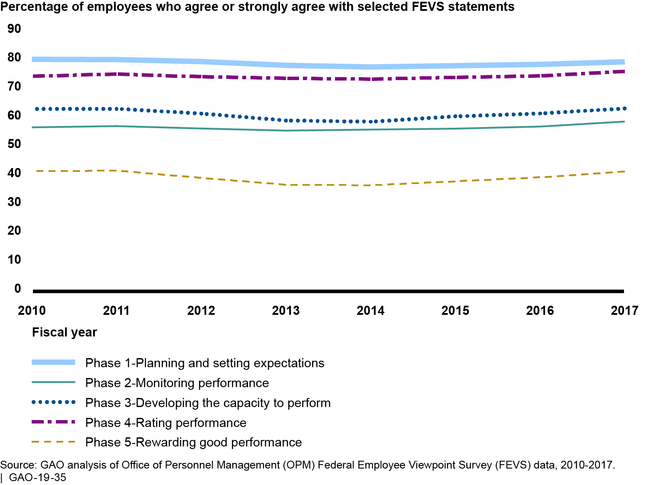Federal Workforce: Opportunities Exist for OPM to Further Innovation in Performance Management
Fast Facts
Agencies need effective performance management systems to hold employees accountable for results and achieve their missions. Although the Office of Personnel Management—the government’s central human resources agency—has identified potentially innovative performance management practices, it needs to do a better job of sharing them with agencies.
We recommended, among other things, steps OPM should take to make this information more accessible.

Graphic showing these 5 phases: planning, monitoring, developing, rating, and rewarding.
Highlights
What GAO Found
GAO found that from 2010 through 2017, surveyed employees generally demonstrated positive responses to selected Federal Employee Viewpoint Survey (FEVS) statements related to four of the Office of Personnel Management's (OPM) five performance management phases, including: planning and setting expectations, monitoring performance, developing the capacity to perform, and rating performance. Employees responded least positively to statements related to rewarding performance, with only 39 percent of employees, on average, agreeing with statements regarding this phase.
Results of Selected FEVS Statements Related to OPM's Performance Management Phases Government-wide, 2010 to 2017

Note: The margin of error for all estimates was within plus or minus 1 percent, except for 2010, when the margin was within plus or minus 2 percent.
Of the four agencies with among the highest average scores for the performance management phases (Bureau of Labor Statistics, Centers for Disease Control and Prevention, Drug Enforcement Administration, and Office of the Comptroller of the Currency), GAO identified practices that may contribute to improved performance management including strong organizational culture and dedication to mission; use of FEVS and other survey data; and a focus on training.
OPM provides guidance and opportunities for agencies to share promising practices on performance management; however, some of this information is not easily accessible on its performance management website. In addition, OPM does not leverage its leadership position to formally identify and share emerging performance management research and innovation with agencies. As a result, agencies, and therefore their employees, may not benefit from the best information available.
Why GAO Did This Study
Managing employee performance has been a long-standing government-wide issue and the subject of numerous reforms since the beginning of the modern civil service. Without effective performance management, agencies risk not only losing the skills of top talent, they also risk missing the opportunity to effectively address increasingly complex and evolving mission challenges.
GAO was asked to examine federal non-Senior Executive Service performance management systems. This report examines (1) government-wide trends in employee perceptions of performance management as measured by the results of selected FEVS statements, (2) practices that selected agencies use to improve performance management, and (3) OPM's guidance and resources to support agency efforts to improve performance management government-wide.
GAO analyzed responses to selected FEVS statements related to the five performance management phases from 2010 through 2017; selected four agencies based on the highest average scores for the five phases, among other criteria, to identify practices which may contribute to improved performance management; reviewed OPM documents; and interviewed OPM and other agency officials.
Recommendations
GAO is making three recommendations, including that OPM improve its website and share innovations in performance management with agencies. OPM agreed with GAO's recommendations.
Recommendations for Executive Action
| Agency Affected | Recommendation | Status |
|---|---|---|
| Office of Personnel Management |
Priority Rec.
The Director of OPM, in consultation with the Chief Human Capital Officers (CHCO) Council, should establish and implement a process for regularly updating the performance management website to include all available guidance and resources, making this information easily accessible, and providing links to other related websites. (Recommendation 1) |
OPM agreed with this recommendation. As of February 2021, OPM stated that they had identified available guidance and resources and have accordingly updated the OPM Performance Management website. Additionally, OPM stated that they have established and documented a process, which is documented via standard operating procedures (SOP), to regularly update the performance management website with available guidance and resources. For example, in the SOP, OPM states that the Performance Management website will be reviewed and updated at least quarterly and that all memoranda pertaining to performance management be made available on the website in a timely manner. As a result of OPM implementing a process to identify and update the Performance Management website, we are closing this recommendation as being implemented.
|
| Office of Personnel Management |
Priority Rec.
The Director of OPM, in consultation with the CHCO Council, should develop and implement a mechanism for agencies to routinely and independently share promising practices and lessons learned, such as through allowing agencies to post such information on OPM's Performance Management portal. (Recommendation 2) |
OPM agreed with this recommendation. To fully implement the recommendation, OPM needs to develop and implement a mechanism that encourages agency stakeholders to share promising practices and lessons learned in performance management. In March 2025, OPM told us that the Performance Management Portal within Connect.gov, which the agency had intended to use as its information sharing mechanism, did not have necessary technical features for agencies to share their practices. OPM stated that the agency has taken some steps to share promising practices for working in a hybrid environment and continued to use its Executive Resources forums to share information with agencies. Identifying and using an alternative sharing mechanism to Connect.gov would help agencies, and therefore their employees, benefit from the best performance management information available.
|
| Office of Personnel Management |
Priority Rec.
The Director of OPM, in consultation with the CHCO Council, should develop a strategic approach for identifying and sharing emerging research and innovations in performance management. (Recommendation 3) |
OPM agreed with this recommendation. To fully implement the recommendation, OPM needs to develop a strategic approach for identifying and sharing emerging research and innovations in performance management. In its March 2025 update, OPM stated it had not made substantive progress in addressing this recommendation due to budget and staffing constraints. In times of limited resources, developing a strategic approach to identify and share such emerging research and innovations would help agencies inform and reform, as needed, their performance management approaches. As a result, federal employees may have more opportunities to maximize their performance.
|
